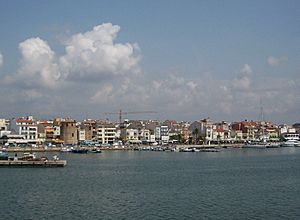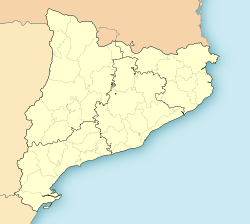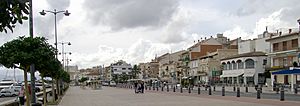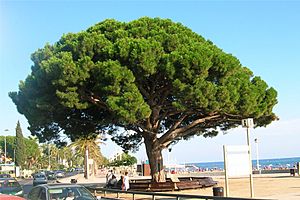Cambrils facts for kids
Quick facts for kids
Cambrils
|
|||
|---|---|---|---|
|
Municipality
|
|||

Cambrils as seen from the sea
|
|||
|
|||
| Country | |||
| Community | |||
| Province | Tarragona | ||
| Comarca | Baix Camp | ||
| Area | |||
| • Total | 35.2 km2 (13.6 sq mi) | ||
| Elevation | 18 m (59 ft) | ||
| Population
(2018)
|
|||
| • Total | 33,362 | ||
| • Density | 947.8/km2 (2,455/sq mi) | ||
| Demonym(s) | Cambrilenc | ||
Cambrils (Catalan pronunciation: [kəmˈbɾils]) is a beautiful coastal town. It is located in the Baix Camp region of Catalonia, Spain. This town is in the province of Tarragona.
Cambrils is very close to the popular tourist town of Salou. Many people who visit Cambrils arrive by plane at Reus Airport.
Contents
History of Cambrils
From Roman Times to the Middle Ages
Cambrils has a very long history. It goes back to prehistoric times. But the town really started to grow during the Roman Empire. We know this because of old sites found there. One example is the Roman farm called La Llosa. It was built near the important Roman road, the Via Augusta. This road was not far from the big Roman city of Tarraco.
By the Middle Ages, people had already settled permanently. They lived on the right side of the Alforja Torrent river. In 1152, the kingdom of Aragon took over Catalonia from the Moors. They offered special deals to encourage people to move to Cambrils.
In the 12th century, a stable town began to form here. It was at the southern entrance to the Camp de Tarragona area. The town was well connected to El Camino Real, which was a royal road linking Tortosa and Tarragona. Cambrils also had good sea connections. In fact, the troops of Jaume I sailed from these beaches in 1229. They went to take back Majorca from the Moors.
A Strategic Town and Its Challenges
Because of its important location, the king kept control of Cambrils. He placed a feudal lord and soldiers there. They also built strong walls and towers to defend the town. These defenses also protected nearby villages like Els Tegells, Les Planes, and Montbrió. This royal effort helped the Old Town grow. It soon had a church, a guesthouse, a chapel, a hospital, a market, and many farmers. These farmers worked the rich land around Cambrils.
However, the town faced a big challenge in December 1640. Cambrils was attacked during the Reapers' War. This war was between Catalonia and King Philip IV of Spain. The people of Cambrils bravely defended their town for three days. But they were up against a much bigger army and eventually gave up. Sadly, the attacking soldiers broke their promise. They killed many defenders and destroyed most of the town walls. This event is very important in the town's history. It is remembered every year with a ceremony in Plaça del Setge (Siege Square).
Growth and Modern Times
From the 18th century, more people began to live in Cambrils. New neighborhoods grew outside the old walls. The coastal area, which is now the port, also started to develop. This happened thanks to the building of the Port or Moors' Tower. For many centuries, living by the sea was dangerous because of constant pirate attacks. Fishermen and others who could not escape to the walled town were often killed or captured.
Other small medieval villages like Mas d'en Bisbe, Vilagrassa, and Vilafortuny also suffered from pirates. Vilafortuny even had its own castle and church. These attacks stopped their populations from growing. This changed when they became part of Cambrils in the 19th century. Over time, as the danger passed, fishing families built their homes around the Port or Moors' Tower. This created the port area. A century later, the harbor was built there. It was finished in the mid-20th century. Today, it is a famous symbol of Cambrils.
In the 19th century, small industries began to grow. Besides making flour in the town's many watermills, there were also liqueur makers. Factories produced bricks and building materials. Boatyards built bigger ships. The opening of the railway in 1867 greatly helped trade, farming, and fishing. This happened even though the 19th century had wars, diseases, and bad weather.
The 20th century brought more people to Cambrils. In the 1950s, many people moved there from other parts of Spain. In the early 1960s, people realized how important tourism could be for the town. Large areas were built to house new visitors. These visitors mainly came to enjoy the Mediterranean sun, beaches, and food.
On August 18, 2017, there was a security incident. A car with five people drove into a crowd walking along the Cambrils seafront. The car overturned, and the people inside got out. They were stopped by the Mossos d'Esquadra (local police). One person died, and six others were injured, including three police officers. It was later found that the people involved had a connection to an incident the day before in Barcelona.
Economy of Cambrils
Cambrils and the area around Tarragona have grown very quickly in the last 20 years. The town used to be mainly about fishing and farming. Now, new industries are growing. These include chemical and petrochemical industries, services, and tourism.
These new industries have led to a lot of development. There have been big investments in roads and other facilities. This has also improved the quality of life. Today, most tourists visiting Cambrils are from Spain. They often have summer homes in this fishing village, which has high-quality beaches.
The Agriculture Cooperative of Cambrils started in 1902. It is now a leading group in farming and food production in the Camp de Tarragona area. Local farmers grow fruits, vegetables, and arbequina olives. From these olives, they make the famous Extra Virgin Olive Oil PDO Siurana. This olive oil has won awards. It was named Best Olive Oil of Spain in the Fruity Category by the Spanish Agriculture Ministry. It also won Best Olive Oil Mill of Spain (2005–2006) from the Spanish Association of Municipalities of the Olive Tree (AEMO).
Tourism in Cambrils
Sights to See
Here are some of the main places to visit in Cambrils:
- Molí de les Tres Eres – This is the main building of the Cambrils Museum of History.
- Museu Agrícola de Cambrils – This is a museum about farming in Cambrils.
- Torre de l'Ermita – A tower near a chapel.
- Torre del Port – The Port Tower.
- Ermita de la Mare de Déu del Camí – A chapel.
- El Parc del Pescador – This is the Fisherman's Park.
- El Parc del Pinaret – This is the newest and largest park in Cambrils.
Beaches to Enjoy
Cambrils has many beautiful beaches:
- Eastern beaches:
- Cap de St. Pere
- Vilafortuny
- Esquirol
- The Cavet
- Prat d'en Forés – Regueral
- Western beaches:
- La Riera
- Horta de Sta. Maria
- La Llosa
- L'Ardiaca
Hiking Trails
The GR 92 is a long-distance walking path. It generally follows the Mediterranean coast of Spain. Cambrils is a stopping point on this path.
- Stage 26 goes north to Tarragona, which is about 28.1 kilometres (17.5 mi) away.
- Stage 27 goes south to L'Hospitalet de l'Infant, which is about 16.3 kilometres (10.1 mi) away.
Notable people
- Francisco Vidal (1868–1943), a cardinal and Archbishop of Tarragona.
See also
 In Spanish: Cambrils para niños
In Spanish: Cambrils para niños








